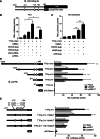Tumor suppressor p53 plays a key role in induction of both tristetraprolin and let-7 in human cancer cells
- PMID: 23595149
- PMCID: PMC3675463
- DOI: 10.1093/nar/gkt222
Tumor suppressor p53 plays a key role in induction of both tristetraprolin and let-7 in human cancer cells
Abstract
Tristetraprolin (TTP) and let-7 microRNA exhibit suppressive effects on cell growth through down-regulation of oncogenes. Both TTP and let-7 are often repressed in human cancers, thereby promoting oncogenesis by derepressing their target genes. However, the precise mechanism of this repression is unknown. We here demonstrate that p53 stimulated by the DNA-damaging agent doxorubicin (DOX) induced the expression of TTP in cancer cells. TTP in turn increased let-7 levels through down-regulation of Lin28a. Correspondingly, cancer cells with mutations or inhibition of p53 failed to induce the expression of both TTP and let-7 on treatment with DOX. Down-regulation of TTP by small interfering RNAs attenuated the inhibitory effect of DOX on let-7 expression and cell growth. Therefore, TTP provides an important link between p53 activation induced by DNA damage and let-7 biogenesis. These novel findings provide a mechanism for the widespread decrease in TTP and let-7 and chemoresistance observed in human cancers.
Figures





Similar articles
-
The role of RNA-binding protein tristetraprolin in cancer and immunity.Med Oncol. 2017 Nov 9;34(12):196. doi: 10.1007/s12032-017-1055-6. Med Oncol. 2017. PMID: 29124478 Review.
-
Ectopic over-expression of tristetraprolin in human cancer cells promotes biogenesis of let-7 by down-regulation of Lin28.Nucleic Acids Res. 2012 May;40(9):3856-69. doi: 10.1093/nar/gkr1302. Epub 2011 Dec 30. Nucleic Acids Res. 2012. PMID: 22210895 Free PMC article.
-
Tristetraprolin mediates the anti-proliferative effects of metformin in breast cancer cells.Breast Cancer Res Treat. 2016 Feb;156(1):57-64. doi: 10.1007/s10549-016-3742-y. Epub 2016 Mar 8. Breast Cancer Res Treat. 2016. PMID: 26956973 Free PMC article.
-
Tristetraprolin regulates expression of VEGF and tumorigenesis in human colon cancer.Int J Cancer. 2010 Apr 15;126(8):1817-1827. doi: 10.1002/ijc.24847. Int J Cancer. 2010. PMID: 19697322
-
Roles of Tristetraprolin in Tumorigenesis.Int J Mol Sci. 2018 Oct 29;19(11):3384. doi: 10.3390/ijms19113384. Int J Mol Sci. 2018. PMID: 30380668 Free PMC article. Review.
Cited by
-
The transcription factor p53: not a repressor, solely an activator.Cell Cycle. 2014;13(19):3037-58. doi: 10.4161/15384101.2014.949083. Cell Cycle. 2014. PMID: 25486564 Free PMC article.
-
The Simultaneous Effects of miR-145-5p and hsa-let-7a-3p on Colorectal Tumorigenesis: In Vitro Evidence.Adv Pharm Bull. 2024 Mar;14(1):231-240. doi: 10.34172/apb.2024.004. Epub 2023 Jul 19. Adv Pharm Bull. 2024. PMID: 38585468 Free PMC article.
-
The role of RNA-binding protein tristetraprolin in cancer and immunity.Med Oncol. 2017 Nov 9;34(12):196. doi: 10.1007/s12032-017-1055-6. Med Oncol. 2017. PMID: 29124478 Review.
-
Dysregulated TP53 Among PTSD Patients Leads to Downregulation of miRNA let-7a and Promotes an Inflammatory Th17 Phenotype.Front Immunol. 2022 Jan 4;12:815840. doi: 10.3389/fimmu.2021.815840. eCollection 2021. Front Immunol. 2022. PMID: 35058939 Free PMC article.
-
Nuclear tristetraprolin acts as a corepressor of multiple steroid nuclear receptors in breast cancer cells.Mol Genet Metab Rep. 2016 Mar 22;7:20-6. doi: 10.1016/j.ymgmr.2016.02.004. eCollection 2016 Jun. Mol Genet Metab Rep. 2016. PMID: 27114912 Free PMC article.
References
-
- Riley T, Sontag E, Chen P, Levine A. Transcriptional control of human p53-regulated genes. Nat. Rev. Mol. Cell Biol. 2008;9:402–412. - PubMed
-
- Vogelstein B, Lane D, Levine AJ. Surfing the p53 network. Nature. 2000;408:307–310. - PubMed
-
- Vousden KH, Lu X. Live or let die: the cell's response to p53. Nat. Rev. Cancer. 2002;2:594–604. - PubMed
-
- Soussi T, Beroud C. Assessing TP53 status in human tumours to evaluate clinical outcome. Nat. Rev. Cancer. 2001;1:233–240. - PubMed
-
- Sbisa E, Catalano D, Grillo G, Licciulli F, Turi A, Liuni S, Pesole G, De Grassi A, Caratozzolo MF, D'Erchia AM, et al. p53FamTaG: a database resource of human p53, p63 and p73 direct target genes combining in silico prediction and microarray data. BMC Bioinformatics. 2007;8(Suppl.1):S20. - PMC - PubMed
Publication types
MeSH terms
Substances
LinkOut - more resources
Full Text Sources
Other Literature Sources
Research Materials
Miscellaneous

